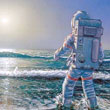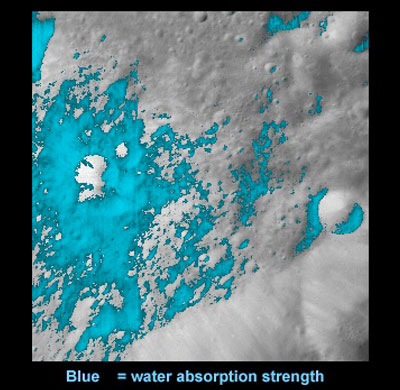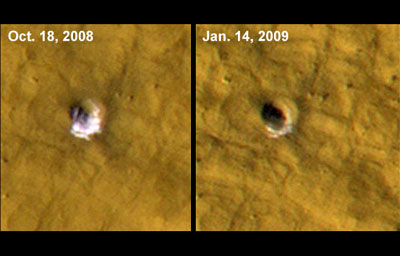 This week in Science Friday we celebrate the discovery of two more water sources in our solar system: Mars and the Moon! Get your sciencey fill by diving into space water, taking a virtual 3D tour of Rome via Flickr, and enjoying another ride to the edge of space (this time in HD!). All this and more plus our gadget of the week: the U3-X aka the UniSegway.
This week in Science Friday we celebrate the discovery of two more water sources in our solar system: Mars and the Moon! Get your sciencey fill by diving into space water, taking a virtual 3D tour of Rome via Flickr, and enjoying another ride to the edge of space (this time in HD!). All this and more plus our gadget of the week: the U3-X aka the UniSegway.
Confirmed: Water on the Moon
It’s official: scientists have found water on the surface of the moon using data from three separate spacecraft. In last week’s Science Friday we talked about finding hydrogen on the moon. Well, this time we’ve detected actual H2O molecules and in greater quantity than predicted. But, we’re not talking lakes. By water on the moon, we mean water and hydroxyl molecules interacting with dust and rock in the very top portion of the lunar soil. The discovery of water molecules and hydroxyl on the Moon raises new questions about the origin of “Moon water” and its effect on lunar mineralogy. Answers to these questions will be studied and debated for years to come. More info at NASA.

Image from Chandrayaan-1 spacecraft showing water on the moon
(Credits: ISRO/NASA/JPL-Caltech/USGS/Brown Univ.)
Orbiter Spots Ice on Mars Exposed by Meteor Impacts
NASA’s Mars Reconnaissance Orbiter has revealed frozen water hiding just below the surface of mid-latitude Mars — a location previously thought to be too warm for such a discovery. Observations show that fresh impact cratering from meteorites is excavating this ice from 0.5-2.5 meters below the surface. Some of the craters show a thin layer of bright ice atop darker underlying material. The bright patches darkened in the weeks following initial observations, as the freshly exposed ice vaporized into the thin Martian atmosphere. One of the new craters had a bright patch of material large enough for one of the orbiter’s instruments to confirm it is water-ice. More at JPL.

Image of an ice-filled crater taken by Mars Reconnaissance Orbiter
CompuSci: Algorithm Generates a Virtual Rome in 3D from 150,000 Flickr Users’ Photos
They came, they saw, they took pictures. And thanks to them — about 150,000 Flickr users — a team of computer scientists built Rome in a day. Using nearly half a million Flickr photos of Rome, Venice, and the Croatian coastal city of Dubrovnik, a team of computer scientists at the University of Washington’s Graphics and Imaging Laboratory assembled digital models of the three cities in 3-D. A series of videos on the project Web site lets visitors fly through landmarks like St. Peter’s Basilica, the Colosseum and Venice’s San Marco Square. For much smaller Dubrovnik, you can see the whole city, including mountains in the distance. Each video includes clusters of small diamond shapes, which represent each photographer and his or her vantage point. (Via PopSci.com)
More From the Edge of Space (in HD!)
In the continuing saga of curious humans sending high-altitude balloons to the edge of space with cameras (or chairs) strapped to them, a group hailing from Edmonton, Canada have one-upped those thrifty MIT kids and their $150 space photo rig, albeit at greater expense: their Canon Vixia HD camcorder sent up on a hydrogen balloon has captured what is probably the world’s first amateur HD video from near-space. Before the balloon burst at an altitude of 107,145 feet (sending the camera on a nauseating free-fall), the camera dutifully recorded over four hours of HD footage, with the memory filling up just 53 seconds after the package parachuted to safety. (Via PopSci)
Video of the Week: Water + Antacid in Space
Don Pettit, frequent member aboard the International Space Station, has become known for doing fun, small science experiments in space and filming them. In honor of our Science Friday “water in space” theme this week, we bring you an experiment showing the nucleation of bubbles in a large water sphere in space due to the reaction with an actacid tablet. Check out the video below; the action starts around 2:40.
Bonus Video: “Bounce” Water Bounces off of a Hydrophobic Surface
The effect seen in this video is known as the “Lotus Effect“, a property of the Lotus flower that repels water from its surface. This is also known as “hydrophobic” (latin for fear of water). The surface at the bottom of the frame is coated in a super-hydrophobic ultrathin layer allowing for droplets of water to bounce off of it. Check it out below!
Gadget of the Week: U3-X aka the UniSegway?
From the land of wacky electronic gadgets (Japan) comes Honda’s newest mobility device. It’s kind of like a cross between a unicycle and a Segway. A UniSegway, if you will. It uses the balance control technology developed during the creation of Asimo, which means that the rider controls speed and direction merely by leaning with their upper body. Unlike most mobility devices, which either put the user above or below the eye level of pedestrians, this thing sits its rider at just the right height. Check out the video below to see it in action.
#FollowFriday
If you are on Twitter, you know there are plenty of amazing people out there tweeting away. And, many of them are scientists! Every Friday I’ll be bringing you a new list of great scientists, techies, geeks, and all around cool people to follow on Twitter. This week…
- @PopSci: Popular Science’s Twitter feed, featuring every article from the magazine, plus online exclusives and more!
- @davidalanmack: Bestselling SF/fantasy author, obsessive-compulsive, husband, cat-lover, drunkard
- @TrekMovie, @kaylai, @charlestrotter: Shameless self plug! Follow TrekMovie’s staff on Twitter!
Science Quickies
Not enough science for you? Here’s a warp-speed look at some more science tid-bits that are worth a look.
- Cause of red color of Mars may not be what you think
- 2009 Lennart Nilsson Award to be presented to Carolyn Porco
- Low-gravity Space Station lab used to study crystal growth
TrekMovie’s Science Friday is an homage the the great NPR radio show Science Friday. Science Friday® is a registered service mark of ScienceFriday Inc.

Wow, that personal mobility thingy looks like something lazy people at work in the office would LOVE. Want coffee? need a copy? why walk when you can get a donut from the break room without even getting up!? ;-)
Back in the 70s, NASA scientists and probably the majority of other scientists felt the running consensus is that there was/is no life in this solar system save here on earth.
Now with our rapidly expanding knowledge base and having found countless signs of water on both Mars, and on the moon– and perhaps other lunar bodies, it seems less and less likely life here on earth is a solitary phenomenon.
Sure, it remains unlikely there is intelligent life on other bodies in our solar system, but rudimentary life forms–even if it is only micro-organisms–seem pretty likely to me.
AND if you couple this with the growing numbers of planets found orbiting other stars, it seems so incredibly likely– and exciting– that we are not alone!
What a beautiful universe we live in!
Mmmmm. Moon Juice.
They found it just in time to help decide whether or not the US goes back to the moon.
Quite the celestial co-inkee-dink.
The personal mobililty thingie looks like something my father could really use. I’ll pass that along to him. He’s pushing 80 and his knees are mostly shot.
Bear-4 means my irrational fear of heights is actually quite rational. Who’da thunk it?
Thanks, Kayla.
Water, water e’erywhar’ yet not a drop ta’ drink…
Oh, wait a tic! Thar’ be some on tha’ moon!
Ahhhhhhh, quench me thirst and… awwwwwwk! Tastes like Alan Shepard’s pee! What’s that ye’ say? Tha’ water is in tha’ soil? So, thar’ arrrrr cats on tha’ moon then?
I see things like that algo-rythm image whens I accidently drink turpentine. Gotta’ stop storin’ it in me juice carton.
That uni-cycle… it… uhhh… doesn’t have a loo, does it? Wait- ye’ control it wit’ yer’ rear? Oh, yer’ upper body movements which translate ta’ yer’ bom then. I had somethin’ like that when I wuz’ a lad. It wuz’ called me Uncle Yorick who bore me on his back coutless times fur’ a piggy-back ride. Had him carry me lazy bom aboot’ until his spine gave oot’ on him. Alas, poor Yorick. I broke him well.
Just like I’d break that uni-cycle thing. Maybe Asimo could carry me then?
Arrrrrrrrrrrrrrrrrrrrrrrrrrrrrrrrrrrrrrrrrrrr…
Could that hydrophobic stuff be applied to cars in the future so we won’t have to keep waxing them?
Another interesting phenomenon is that some of the most hydrophobic substances on earth are children between the ages of 5 and 12 on a school night.
Really cool watching the home made pictures from space arms race. only a matter of time until somebody sends themselves up. We shall see if they are successful or if they make a resounding Goosh-ala!
If those little fold-out seat thingies on that “personal mobility device” failed, that could get mighty uncomfortable, mighty quickly.
Also, the “alkaseltzer in space” video was cool. The guy doing the experiment sounds like the quintessential science geek, which makes it all the more fun.
#7
Agreed on both your points. I smiled upon hearing Don Pettit describe the experiment and the geeky humor he interjected. Full on science guy mode and there ‘aint nothing wrong with that.
You go with your nerdy science self, Don!
Kudos to the Edmonton Gang. Impressive feat! Now, if they’d only built a badminton-birdie type carriage, so that the camera would have kept a level orientation as it fell (it’s doable, without too much added weight.) Next thing you know Captain Kirk will come orbital skyjumping after it. ;)
As to water on the Moon… since the solar wind is constantly dumping hydrogen ions (protons) on the surface rich in metal oxides… those protons can easily reduce some of that and create OH- radicals, which can combine with another solar wind proton H+ to create H2O. Considering that process has run for 4.5 billion years, is it really any surprise to find water on the moon?
The unisegway could usher in a new era for paraplegics and other disabled people. There’s its use, #1.
Hey, for fun at home, just drop an Alka Seltzer in a flower vase, and put a balloon over the top. It’s a blast of gas in the making. :)
Dear God! We find pee on tha’ moon and Mars and thar’ be only 9 comments!!!!!
What a primitive, paranoid culture we live in…
They’ll find poo on Uranus next and no one will care… Gotta’ think outta’ earthly matters, me mates!
Now, whar’ be me sextant? Tonight I map Orion’s sack… errrrrrr… uhhhhh… I mean Cass’eee’opie’s crown? Hmmmmm… Best stick ta’ literature o’er space stuff…
Star light, star bright
Most beautiful thing that I see this night…
T-Tori me all away so
In yer’ fusion fray so as ta’ glow…
Me gin woulda’ not last a tic on tha’ hottest blue giant though…
Arrrrrrrrrrrrrrrrrrrrrrrrrrrrrrrrrrrrrrrrrrrrrrrrrrrrrrrrrrrrrrr…
Do you have a link to a bigger version of the first picture? It’s kinda cool and I want to use it as a desktop.
I can’t help but wonder about the cosmic implications of finding poo on Uranus from #10’s comment…hmmm…
The nice thing about finding water in places out there is Water gives higher odds life may be out there. May be not the kind that will shake your hand. Better odds of it thinking your offering free food and bite it off and have a snack.
Then water means basically cheap air and fuel. Always knew water on Mars, but getting easier to find, That makes the Mars Direct guy that use to work at whats now called Lockheed Martian back when the Vikings landed. This way we can make fuel for a return trip and not heed even a bigger ship to bring thr return fuel. That cuts the trip price by a 1/3rd to a half the cost.
But thats if we use Rocket fuel for Interplanetary travel, the other option is ION engines for Space travel, but you still need rocket fuel to land and take off the standard ways. There are other ideas but for now they are ideas. But in 20 to 30 years landings and take offs may be done in other ways.
Plasma may replace the heat shields and become a force field like protector. Aerodynamics needs atmosphere is needed. Rocket engines is the standard way but it is far from the best ways for Orbital Transitions.
Getting up and down from space is hard and needs much technology to be done, until a much easier way is found or created, most of earth’s people will be stuck on this blue marble in space.
And if you can create better ways you may become the next Ford or Wright Brother.
Tha’ cosmic implications aboot’ poo on Uranus arrrrrr very fascinatin’…. SciFiMetaGirl, we have much ta’ discuss… I live in tha’ live chattie room… got me a blankie thar’ and some company…
And…
I wonder how tha’ production designer thread got o’er a hundred posts and this here real science thread only gets 14? By Crom’s beard, mates! Kayla brings us these odd bits o’ news more important than Obama speakin’ in Cincinnati!
Thanke’ Kayla… if thar’ be water on Mars, I’ll make ye’ a BND Brand Gin and tonic… wit’ a wee spot o’ landing module dew as well fur’ tha’ lunar flavor…
(Oh, I kidz cuz’ I loves… I also moons cuz’ I loves)
Arrrrrrrrrrrrrrrrrrrrrrrrrrrrrrrrrrrrrrrrrr…
Did anyone post about the Star Trek Replicator?
http://www.nasa.gov/topics/aeronautics/features/electron_beam.html